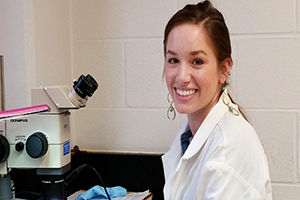KSU student to present new circadian rhythm research

Photo courtesy of Kent State University
March 11, 2015
A team of chemistry and biology undergraduate and graduate student researchers recently concluded research involving circadian rhythm structures.
Circadian rhythms are physical, mental and behavioral changes that follow a 24-hour cycle, responding to light and darkness in an organism’s environment, according to the National Institute of General Medical Sciences’ website.
“We’re trying to get a better idea of how certain factors can change our circadian rhythms as far as the entire population goes,” said Caitlin Crosier, a senior Chemistry major. “Until now, most of the research has been done in small and controlled environments on certain populations, such as adolescents or shift-working people.”
Adam Stowie, Crosier’s supervisor for the project and a graduate student in the biological science-physiology department, said that it is normal to have undergraduate students simply participate in research projects; however, Crosier is a different case.
“Her involvement in all of the stages of the project was quite large, which is unusual for undergraduates,” Stowie said. “I’d like to emphasize how proud we are in Caitlin’s accomplishments in this project and all of her work in the lab.”
Crosier is presenting her team’s published research at the Undergraduate Research Symposium in Cunningham Hall on March 11.
Crosier worked under J. David Glass, a professor of biological sciences.
Glass said that the project started in September 2013, when he found a database used for this research project, and was completed in April 2014.
Caitlin’s article, based on circadian research, was published in Chronobiology International in October 2014.
The data showed the relationship between people’s sleep schedules and daylight savings time, Glass said. The data measured how much time people spend in the dark or artificial lighting, as opposed to natural lighting, during the summer and winter seasons.
“We think that [the amount of time people are in lighting] correlates strongly with the etiology of seasonal affective disorder (SAD),” Glass said. “During the transition… from standard time to daylight savings time… the one hour shift we get is associated with a 25-35 percent spike in cardiac mortality (death from heart attacks).”
For Crosier, the research process on this topic was something she wasn’t used to. Crosier said that the experience was “exciting” and “definitely a different experience.”
“There’s no rubric or syllabus to tell you ‘here’s this and you’re going to get this grade if you do this work,’” Crosier said. “(Your work) has to be the best. “
Contact Jacob Runnels at [email protected].
























